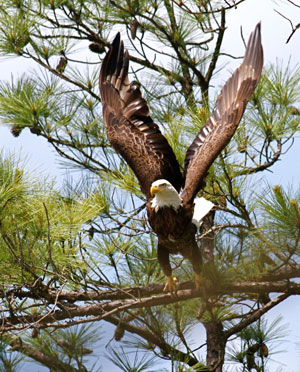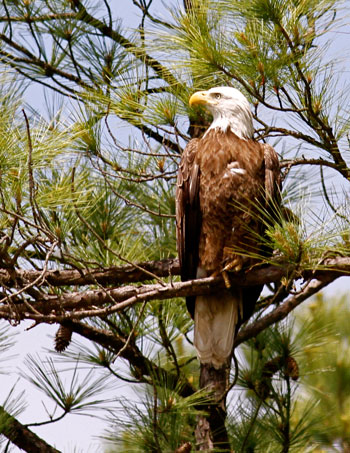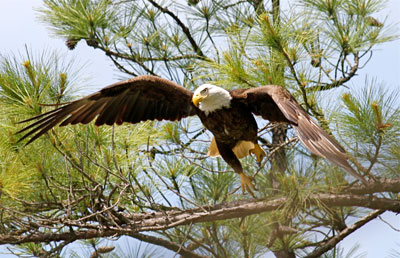
by Mary Parker Sonis
As the Fourth of July approaches, my thoughts this month turned to the most famous of American birds, the bald eagle. Any fifth-grader knows the basic facts about this bird. It is a raptor exclusive to North America, it is very large and Ben Franklin argued that it was a contemptible creature. In a letter to his daughter, he wrote that the bald eagle “is a bird of bad moral character. He does not get his living honestly. You may have seen him perched on some dead tree near the River, where, too lazy to fish for himself, he watches the Labour of the Fishing Hawk; and when that diligent bird has at length taken a fish, and is bearing it to his nest for the Support of his mate and young ones, the Bald Eagle pursues him and takes it from him.â€

Franklin went on in the letter to extol the virtues of the turkey, “though a little vain and silly, a Bird of Courage, and would not hesitate to attack a Grenadier of the British Guards who should presume to invade his Farm yard with a red Coat on.â€
Mr. Franklin posed an excellent argument, but the American character has long appreciated the large and powerful, and the bald eagle became our national emblem in 1782.
Much of what Franklin asserted is true – perhaps not the moral attributes, but certainly his description of the bird’s behavior. The bald eagle has three means of acquiring food. They steal prey from other animals, they scavenge carrion and they actively hunt. Perhaps we so admire this bird because it is an American success story. Early settlers thought the bird was vermin and regularly shot them from the sky. As an apex predator, the bald eagle was viewed as a competitor for fish in those very-early days of colonization. It is estimated that in 1782, the population of bald eagles in the lower 48 states was in the range of 100,000.

Due solely to the changes brought about by human actions, the population of bald eagles declined every year. Many were shot, and many western populations starved when the bison and passenger pigeons were eliminated from the range. By the 1880s the bald eagle was in serious trouble. When the outlook started to look particularly bleak, legislation known as the Bald Eagle Act was put into place to offer some protection to these magnificent birds, but this protection did not go into effect until 1940.
Modest gains were made, but then the final blow was struck when DDT was introduced as an agricultural pesticide. The darkest hours for our great American bird came in 1963, when the population of bald eagles in the lower 48 states fell to 487 pairs. Perilously close to extinction, the beleaguered eagle came back when DDT was banned as a pesticide, and in 2006 the lower 48 state population of bald eagles was counted as 9,789 breeding pairs. The largest population of bald eagles presently lives in Alaska. It is thought that of the world population of 80,000 to 100,000 bald eagles, 40,000 to 50,000 live in Alaska.
I think of this as a particularly American success story. When colonials came to the U.S., they saw this handsome bird as vermin and hunted it down. It was then admired and made into the national emblem for the United States. The soaring eagle stood for American freedom. Unfortunately, the freedom extended to allowing anyone to hunt and kill eagles. Wetlands were destroyed, rivers were polluted and overfished and, finally, the eagle was almost poisoned to death. Freedom came with a heavy price. The eagle represents more than the power of a great nation; it represents the struggle for equality in a nation that took its natural resources for granted.
As a photographer, my own experience with bald eagles has always centered on trips to Jordan Lake. I have never had the pleasure of seeing the vast congregations of eagles in Alaska, but with a bit of effort I can count on viewing eagles on any trip to the public access beaches that surround Jordan Lake. They are wary birds, and I generally try to take cover behind dense vegetation to view these grand raptors. With visual acuity estimated to be four to seven times greater than perfect human vision, it is not easy to approach a bald eagle. Occasionally, I will be completely unobserved, and I get the chance to watch the eagles interact.
One early morning at Ebenezer, I managed to glimpse a pair of eagles as they communicated to each other while perched in a tall pine by the water’s edge. I was close enough to hear the calls clearly. The call of the bald eagle is particularly weak, shrill and high-pitched. It is a puny little sound for an animal that is three feet long and has a wingspan of six-and-a-half feet. How could this be? Is the bald eagle the Mike Tyson of the bird kingdom? The sound is such a miniscule squeak that when you see footage of bald eagles in movies, the moviemakers have often actually dubbed in the far-reaching, lonely cry of the red-tailed hawk. How much more American can this story get? Our national bird has a Hollywood voice-double.

In flight, there is grandeur to an eagle. The wing beats are slow and strong. Through the magnified eye of a telephoto lens you can clearly visualize the muscular yellow feet that measure a full six inches when spread. The liftoff is sure and focused, a photographer’s dream capture. In flight, the wing stretches out as straight and flat as a board. Sometimes you can distinguish an eagle from circling vultures simply by the set of those straight wings.
Befitting American style, the nest of a bald eagle is a splendidly large affair. Although the original construction can take a mere four days to accomplish, as the eagles return year after year, they add to their nest of sticks until it reaches mammoth proportions. The largest observed nest was located in Florida, measuring nine and a half feet across and weighing nearly two tons.
Chronicling four centuries, the bald eagle has been called vermin, thought to be closely akin to “those among men who live by sharping and robbing,†embraced as an emblem of freedom and liberty, nearly poisoned to extinction and finally hailed as a revered symbol of American endurance in the face of adversity. Somewhere between moral turpitude and determined altruism, an American icon has survived.